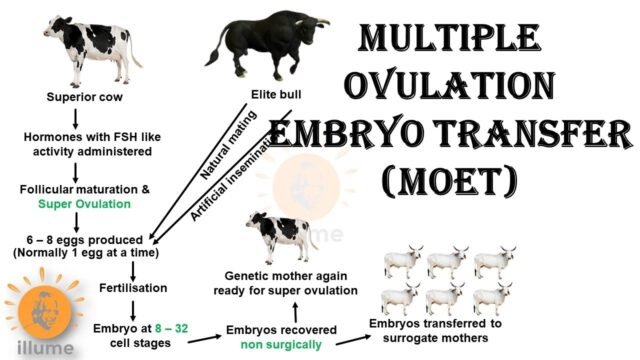
Department of Animal Genetics and Breeding, College of Veterinary and Animal
Science, Bikaner, RAJUVAS
Embryo transfer technology (ETT) is a technique by which embryos are collected from a donor female and transferred to recipient females that act as surrogate mothers for the rest of the pregnancy.
Also called as Multiple Ovulation and Embryo Transfer (MOET) Technology, is used to increase the reproduction rate of superior female dairy animals. Normally, one can get one calf from superior female dairy animals in a year. But by using MOET technology, one can get 10-20 calves in a year from a cow/buffalo. An elite cow/buffalo is administered hormones with FSH-like activity to induce super-ovulation.
The first embryo transfer technology (ETT) project in the country was initiated by NDDB in 1987 by establishment of a central ET laboratory at Sabarmati Ashram Gaushala (SAG), Bidaj.
Under this project, NDDB established one Main ET Lab at SAG Bidaj and four Regional ET Labs at CFSP&TI, Hessarghatta (Karnataka), ABC, Salon (UP), Shri NashikPanchavati Panjrapole, Nashik (Maharashtra) and Buffalo Breeding Centre, Nekarikallu (AP). NDDB also assisted in establishment of 14 State ET centers across the country.
SAG has done pioneering work in this field and has so far produced 14388 viable embryos and 755 calves, which is highest by any organization in the country. Of these, 1026 embryos are of indigenous cattle breeds, from which 122 calves have been born. Besides these, around 3000 embryos of buffalo breeds have also been produced. Under the project, the first buffalo calf of India from frozen thawed embryo was born in the year 1991.
Early embryos of superior genotype are collected prior to their implantation in uterus, and they are implanted in the uterus of other females of inferior genotype where they complete its actual development which is referred to as embryo transfer.
Applications of Embryo Transfer:
1) Faster genetic improvement
2) Genetic screening
3) Disease control
4) Import and export
5) Circumvention of infertility
6) Twining in cattle
7) Conservation of endangered species
8) Research/production of clones/and genetic engineering
Advantages of Embryo transfer technology (ETT)
• Increase the number of offspring sired from superior females.
• Results in faster genetic progress.
• Obtain offspring from old or injured animals incapable of breeding or calving naturally.
• Increase farm income from sale of embryos.
• Export/import of embryos is easier than with live animals
Disadvantages of Embryo transfer technology (ETT) Programme
• Costly and success rate are less than AI
• Cost and maintenance of recipient females
• Requires a technician with the skills to flush embryos from the reproductive tract
• Possible spread of diseases through recipients
NiteshJat1 *,Yashmita Shekhawat1,Suman1,Vaishali Pareek1,Radha Rani Sawami1,Anju Kumari1
*Corresponding author: nitesh.bana78@gmail.com

















